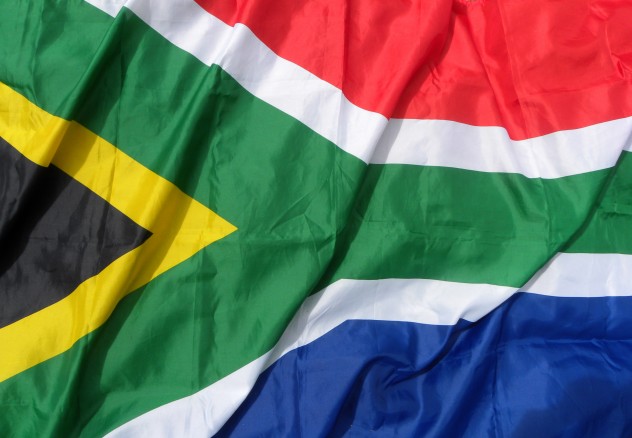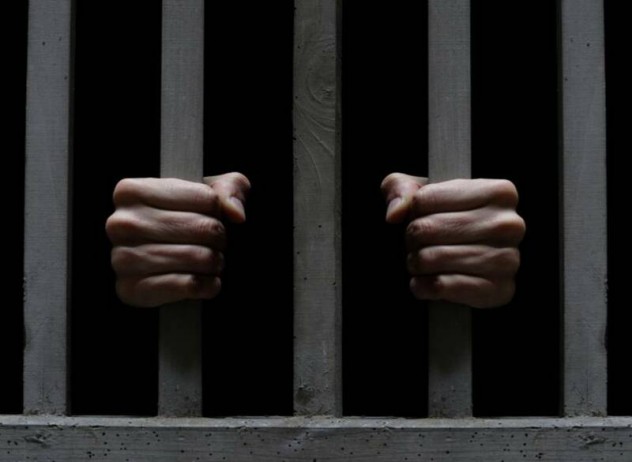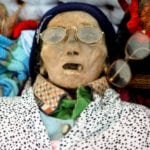 Food
Food  Food
Food  Sport
Sport 10 Lesser-Known Multi-Sport Alternatives to the Olympics
 Humans
Humans 10 Real Life Versions of Famous Superheroes
 Gaming
Gaming 10 Overused Game Villains
 Mysteries
Mysteries Ten Mysterious “Ghost Ship” Stories That Still Keep Us Wondering
 Technology
Technology 10 Times AI Replaced Humans (and No One Noticed)
 Politics
Politics 10 Dreaded Despots Who Met Untimely Deaths
 Pop Culture
Pop Culture 10 Celebs Who Have Surprisingly Wanted to Be on Reality TV
 Creepy
Creepy 10 of the Strangest Popular Creepypastas
 Animals
Animals 10 Animals That Used to Be Bigger
 Food
Food 10 Foods That Have Alleged Occult Powers
 Sport
Sport 10 Lesser-Known Multi-Sport Alternatives to the Olympics
 Humans
Humans 10 Real Life Versions of Famous Superheroes
Who's Behind Listverse?

Jamie Frater
Head Editor
Jamie founded Listverse due to an insatiable desire to share fascinating, obscure, and bizarre facts. He has been a guest speaker on numerous national radio and television stations and is a five time published author.
More About Us Gaming
Gaming 10 Overused Game Villains
 Mysteries
Mysteries Ten Mysterious “Ghost Ship” Stories That Still Keep Us Wondering
 Technology
Technology 10 Times AI Replaced Humans (and No One Noticed)
 Politics
Politics 10 Dreaded Despots Who Met Untimely Deaths
 Pop Culture
Pop Culture 10 Celebs Who Have Surprisingly Wanted to Be on Reality TV
 Creepy
Creepy 10 of the Strangest Popular Creepypastas
 Animals
Animals 10 Animals That Used to Be Bigger
9 Obscure Concentration Camps
The term “concentration camp” has become synonymous with Nazi Germany—and rightfully so—yet we often forget about the similar camps that existed before and after World War II. If pressed, Stalin’s gulags come to mind as well as Cambodia’s killing fields, and some might even call Guantanamo Bay a modern gulag. But there are plenty more camps, often forgotten, that were and are just as shocking.
9 Sri Lankan Concentration Camps

There’s some debate about whether the camps formed during the Sri Lankan Civil War were legitimate concentration camps or, as the Sri Lankan government described them, “welfare centers.”
Originally, innocent civilians were put into the camps for their own protection, since hundreds of thousands of them were trapped in the battle zone. Instead of being called inmates or detainees, the people were referred to as “internally displaced persons” (IDPs). Regardless of their label, the fact that they were held there against their will and with minimal provisions suggests that, at the very least, the facility was an internment camp. Amnesty International, aid organizations and the international community in general spoke out against the deplorable conditions until the Sri Lankans were eventually pressured to increase the openness of the camps by allowing the IDPs to leave the grounds for limited amounts of time.
The camps were officially closed in 2012, but it’s estimated that 100,000 IDPs still remain in the camps or in transit centers.
8 Spain’s ‘Reconcentration’ Camps In Cuba

By 1896, Spain had failed to stifle the rumblings of the Cuban Rebellion, and it was obvious to the Spanish that they had to regain control of their colony. So they sent in the merciless General Valeriano Weyler, later nicknamed Butcher Weyler, who resorted to concentration camps to control the insurgency.
General Weyler rounded up rural Cubans and, claiming it was for their own protection, moved them to camps where they were given minimal provisions and essentially left to fend for themselves in a place with virtually no resources. After announcing his reconcentration policy, the citizens had eight days to report to the camps or they’d be shot. The captives were made to live in a squalid environment with inadequate shelters, scarce food, and rampant disease. Over 400,000 Cubans died in the camps, which has led some to refer to it as the Cuban Holocaust.
Tales of Cuban cities filled with naked, skeletal people reached the US and were instrumental in pushing the Americans into the 1898 Spanish-American war.
7 Cuba’s Camps For ‘Social Deviants’

Apparently having forgotten the atrocities they endured in concentration camps under Spanish rule, in the 1960s, Cuba began putting some of its own citizens into camps, without trial and often without explanation. Obviously counterrevolutionaries and those who opposed the new Castro regime were locked away, but so-called “deviants” were prime targets as well. That included homosexuals, people with HIV or AIDS—there was mandatory nationwide testing—Jehovah’s Witnesses, and others. Acting under the authority of Che Guevara, officials went door to door through every city and town arresting anyone who fit the “deviant” description.
Gay men were seized by the thousands and sent to labor camps, where the motto “work will make you men” ruled their lives. When not toiling in sugar cane fields, these inmates suffered great humiliation, torture, hunger, and death. Many resorted to suicide instead of enduring the endless misery and abuse. Apart from the climate, the descriptions of these camps are indistinguishable from Stalin’s gulags.
6 Britain’s Concentration Camps In South Africa

During the South African War of 1900–1902, British forces attempted to weaken and demoralize the Boers—Dutch settlers in the region—by interning their women and children in 45 concentration camps throughout South Africa. Additionally, 107,000 black people were pushed into the camps where many were used as slaves.
Although unjust from the start, things became decidedly worse when Herbert Kitchener, legendary supporter of the “scorched earth policy,” took over as commander in chief of South Africa. Under his control, women, children, and black people were herded by the hundreds of thousands and indiscriminately thrown into the already inadequate and overcrowded camps. Similarly, thousands of men—those who weren’t shot on the spot—were put in prison camps, where most of them died or were sent overseas.
Those in the camps were neglected, given scanty food rations, and left to suffer as measles, typhoid, and other diseases ran rampant. Over 26,000 women and children died, and it’s believed that about 14,000 black inmates perished.
5 US Concentration Camps In The Philippines

About the same time the British were trying to take control of South Africa, the United States was attempting to maintain a stronghold over one of its newly acquired colonies, the Philippines. During the Philippine-American war, the Americans ordered entire populations of people into concentration camps with the promise that those who did not comply would be assumed to be in favor of the insurgent forces and “dealt with accordingly“—in other words, shot. And as with Herbert Kitchener’s scorched earth approach, the US Army burned anything the captives left behind so it couldn’t be used by the “enemy.”
Ironically, the “reconcentrado policy” was eerily similar to the Spanish camps in Cuba, which the Americans had so publicly detested just a few years before. The conditions were also comparable, as disease was rampant and the Filipinos lacked proper food, clothing, and housing—not to mention that interrogations and torture were commonplace.
Roughly 300,000 Filipinos were driven into camps and kept there under gunpoint. While it’s unclear how many perished overall in such a hostile setting, as much of 20 percent of the population died in some camps.
4 Vietnam’s Reeducation Camps

At the end of the Vietnam War, the Southern Vietnamese people who’d fought with the US had two choices—flee the country and become boat people or stay and risk punishment by the Socialist Republic of Vietnam. Despite being told that they only needed to attend a 10-day reeducation camp, the South Vietnamese who stayed behind were shoved into horrifying concentration camps where the average stay was actually three to 10 years.
Although the camps were specifically for former military and government workers of South Vietnam, essentially anyone suspected of having anti-socialist tendencies was thrown, without trial, into the penitentiary. In the end, as many as 2.5 million people were assigned to reeducation.
The Vietnamese presented the camps as humane places where treasonous people could repent and reintegrate into society. Unfortunately, the government’s idea of reeducation more closely resembled torturous brainwashing. Among other things, prisoners were beaten, shackled, constantly forced to confess their “crimes,” and continually indoctrinated about the evils of America and the superiority of Vietnam. Above all, hard labor was viewed as the key to reeducation. Thus the inmates toiled away for years and decades in back-breaking and dangerous work, such as digging wells, clearing the jungle, and sweeping minefields.
Like so many other camps we’ve mentioned, the death rate was high, as disease and starvation were unavoidable. There are few records of the inmates, but it’s estimated that 165,000 people died in the camps.
3 Chile’s Dawson Island Camp

Outside Stalin’s Siberian gulags, there was perhaps no other concentration camp as cold, isolated, and climatically harsh as Dawson Island. This island camp was located in the middle of the Strait of Magellan, in one of the southernmost human settlements before Antarctica. Naturally, its proximity to the South Pole meant it was often thrashed by freezing Antarctic weather and blistering storms.
The island’s history as a concentration camp dated back to the 1800s, when Italian missionaries transported the Selknam people, a Patagonian aboriginal group, there for the purposes of education and religious study. More recently, Dawson Island was used as a military prison camp after the Chilean Coup of 1973. It incarcerated high-profile political prisoners from the ousted Salvador Allende government.
The details of life at the camp are, by now, depressingly familiar. There was minimal food, a lack of clean water, exhausting work, and scanty medical care. Despite the sub-zero temperatures, many inmates were refused blankets and clothing, and the unexplained disappearance of fellow prisoners kept the men constantly in fear.
In 1974, after an investigation by the Red Cross, the camp was shut down and the inmates were transferred to other prisons on the mainland.
2 Portugal’s Tarrafal Camp In Cape Verde

After serving as a slave-trading post for 300 years, Cape Verde continued on its tumultuous path by becoming home to the dreadful Tarrafal Camp, otherwise known as the “Camp of the Slow Death.”
It was initially created in 1936 by the Portuguese dictator Antonio de Oliveira Salazar for communists, anarchists, anti-colonialists, liberals, and anyone who was against his corporate, conservative (albeit authoritarian) regime.
Prisoners who were accustomed to the cooler climates of Europe sweltered in the colony’s year-round scorching temperatures. One of the most notorious forms of punishment was the “frying pan,” which was a solid concrete, box-shaped cell where captives were left to bake in the sun. Many lived in these circumstances for years and others never made it out alive.
Due to pressure from the international community, the camp closed in 1954. However, it reopened in the 1970s to imprison African leaders who were fighting the Portuguese for independence. As if conditions weren’t bad enough during the 1930s to 1950s, the Portuguese stepped up the oppression of African captives. Moat-like trenches, concrete walls, barbed wire, and other additions made the camp resemble a medieval fortress. And inspired by the Nazis, torture chambers were set up to deal with the most disagreeable inmates.
During the Carnation Revolution, the beleaguered and feeble prisoners were finally released—the camp has been closed ever since.
1 Bosnia-Herzegovina’s Omarska Camp

During the 1992–1995 Bosnian War, hundreds of concentration camps were set up by the Bosnian Serbs for the purpose of cleansing the country of non-Serbs. Omarska, one of the most infamous camps, detained 5,000 to 7,000 Bosnian Muslims (Bosniaks) and Croats.
In an attempt to prove they were merely housing refugees in “centers” and not imprisoning undesirables in “camps,” Serb authorities allowed the media a brief glimpse into the Omarska dining facilities. Of course, their attempt at openness backfired, as the world was shocked to see emaciated, hollow-eyed men staring back at them on the nightly news. The scenes seemed like something straight out of Auschwitz and caused such an international incident that the camp was shut down within a month after the media coverage.
Before the closure, captives were forced to live in an open-pit iron mine where they were exposed to extreme weather and crammed in so tightly that lying down was impossible. Approximately 2,000 Bosniaks and Croats were killed or died from the conditions, and survivors say the dead bodies were stacked so high that they had to be carried off with a forklift.
Around 100,000 people died in the Bosnian genocide—almost half Bosniaks—and Serbian leaders are still being tried for war crimes today.
Content and copy writer by day and list writer by night, S. Grant enjoys exploring the bizarre, unusual, and topics that hide in plain sight. Contact S. Grant here.







